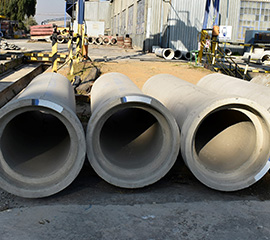 The use of Calcium/Dolomite (CAC/DOL) concrete as a corrosion control layer for concrete sewers has been based on information obtained from the testing of various cementitious materials in an aggressive real-life situation. This technique has been used in South Africa since 1997, and has proved to be both technically sound and cost-effective for sewers where conditions are aggressive and the cost of a cast in High-density Polyethylene (HDPE) lining cannot be justified.
The use of Calcium/Dolomite (CAC/DOL) concrete as a corrosion control layer for concrete sewers has been based on information obtained from the testing of various cementitious materials in an aggressive real-life situation. This technique has been used in South Africa since 1997, and has proved to be both technically sound and cost-effective for sewers where conditions are aggressive and the cost of a cast in High-density Polyethylene (HDPE) lining cannot be justified.
This is because the material is about four times as effective in dealing with corrosion as the Portland Cement/Dolomite (PC/DOL) solution and at least ten times as effective as standard Portland Cement/Silicate (PC/SIL) concrete.
Handling and Installation:
When handling any concrete products, it is important to remember that, as concrete is a heavy and somewhat brittle material, bumps or shock loads of any description are liable to damage the product. This applies particularly to sharp edges.
When offloading the products on site, the equipment must not damage the products. Sewer pipes do not have a lifting hole, as the system must be watertight. A 150mm sling passing around the center of gravity of the pipe must be used to handle the product. When placing the product on the ground, it is important to note that the pipe must not rest on the socket portion. The full weight of the pipe must be borne by the barrel of the pipe.
During the installation, the trench or excavation must be prepared to the Site Engineers specification. Once the bedding is in place it is ready for the pipes. The specific area where the socket end would rest must be removed, so that the pipe can be horizontal during installation, and that the pipe can rest on the barrel once in place.
Each pipe must be sealed with a rubber ring. This must be place on the spigot end and located in the correct position as indicated by the locating groove. The rubber ring must be of equal tension around the barrel. This can be attained by inserting a screwdriver, or similar object, between the ring and the pipe, and running the screwdriver around the barrel twice.
The pipes are lowered into place using the same handling technique as before. Once the pipes are lined up, it will be necessary to pull the spigot end into position to fit into the socket end of the already laid pipe whilst the pipe is still suspended. This can either be done by levering the pipe forward, or by means of a tirfor system, which pulls the pipes together.
Once this is completed, and the pipe is correctly sealed, the pipe can be released to lie on the bedding. It must be noted that again, the full weight of the pipe must rest on the barrel only and not on the socket area. The next pipe can then be lowered into position.
Backfilling of the pipe to the engineer’s specification is of utmost importance, as the pipe strength is designed to suit the installed condition. Care must be taken to compact underneath the pipe curvature to ensure a good foundation is in place. For more information on pipe installation, please use the contact us facility, as our staff can be of assistance on site with the installation activities.

